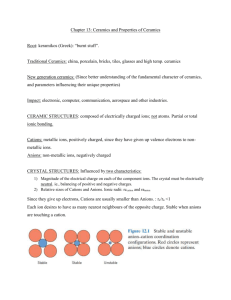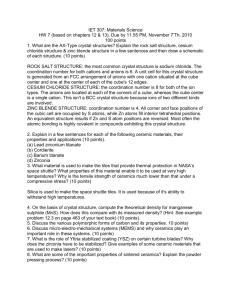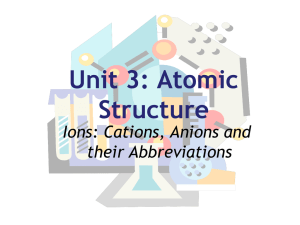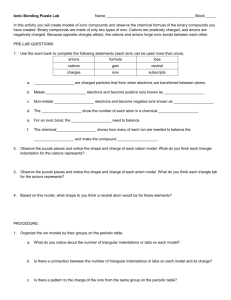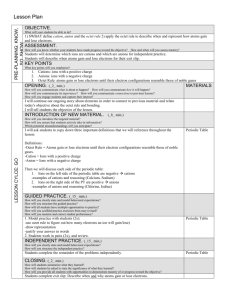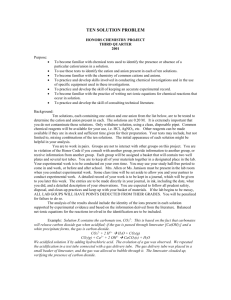A m B n X p -TYPE CRYSTAL STRUCTURE
advertisement
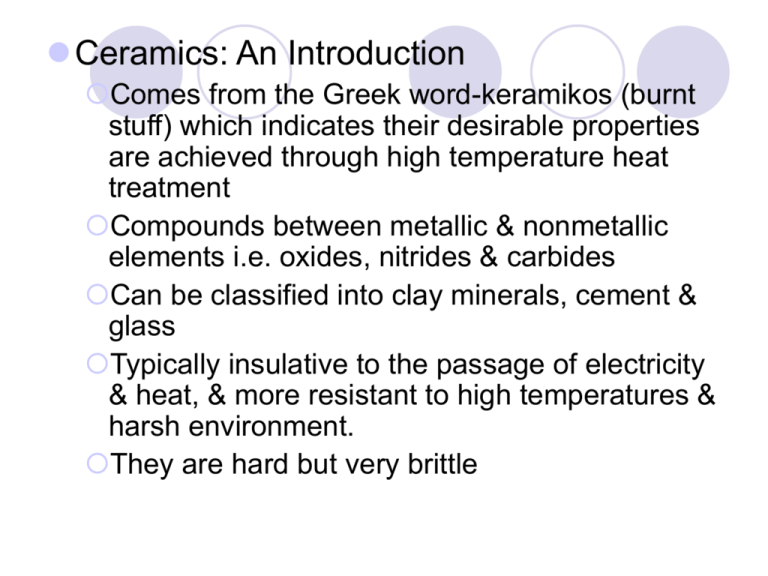
Ceramics: An Introduction
Comes from the Greek word-keramikos (burnt
stuff) which indicates their desirable properties
are achieved through high temperature heat
treatment
Compounds between metallic & nonmetallic
elements i.e. oxides, nitrides & carbides
Can be classified into clay minerals, cement &
glass
Typically insulative to the passage of electricity
& heat, & more resistant to high temperatures &
harsh environment.
They are hard but very brittle
Classification of Ceramics
Ceramic Bonding
Mostly ionic, some covalent.
% ionic character increases with difference in
electronegativity
Large vs small ionic bond character:
Adapted from Fig. 2.7, Callister 6e. (Fig. 2.7 is adapted from Linus Pauling, The Nature of the
Chemical Bond, 3rd edition, Copyright 1939 and 1940, 3rd edition. Copyright 1960 by
Cornell University.
Two characteristics of the component ions in crystalline
ceramic materials which influence the crystal structure:
The magnitude of the electrical charge on each of the
component ions:
The crystal must be balanced by an equal number of anion
–ve charges
The relative sizes of cations & anions
This involves the sizes or ionic radii, rC & rA respectively
The ratio of rC/rA is less than unity due to cation size that is
small. This is caused by the metallic elements give up
electrons when ionized
Stable ceramic crystal structures form when those anions
surrounding a cation are all in contact with the cation
The coordination no. is related to rC/rA radius ratio
For a specific coordination no., there is a critical or min rC/rAratio for
which this cation-anion contact is established
This ratio maybe determined from pure geometrical considerations
The coordination numbers and nearest neighbor for various rC/rA
ratios are presented in the next table.
Example Problem 12.1
Show that the minimum cation-to-anion radius ratio for the
coordination number 3 is 0.155
Solution:
The small cation is surrounded
by 3 anions to form equilateral
triangle.The centers of all four
ions are coplanar
AP = rA & AO = rA + rC
Note: the side length ratio AP/AO
= cos α
The magnitude of α is 30o, since
line AO bisects the 60o angle
BAC: AP/AO =rA/rA+rC=30o
=√3/2
The cation-anion radius ratio;
rA/rC=(1- √3/2) / √3/2 =0.155
AX-TYPE CRYSTAL STRUCTURES
Some ceramic materials have equal number of cations &
anions
These are referred as AX compounds: A-cation & X-anion
Rock Salt Structure
•A common example for AX crystal
structure. Coordination no. is 6 rC/rA
ratio between 0.414 & 0.732
•A unit cell is generated from an
FCC (Face Centered Cubic)
arrangement of anions with one
cation situated at the cube
center & one at the center of
each of 12 cube edges
•An equivalent crystal structure
results from a face-centered
arrangement of cations
The rock salt crystal is thought of a interpenetrating FCC
lattices.
One composed of the cations, the other of anions
NaCl, MgO, MnS, LiF, FeO
Cesium Chloride (CsCl)
Structure
•Coordination no. is 8 for both ion
types
•The anions are located at each of
the corners of a cube
•The cube center is a single cation
•Interchange of anions with
cations,vice versa, produce same
structure
• Zinc Blende (ZnS)
Structure
• Coordination no. is 4, all ions
are tetrahedrally coordinated
• All corner and face positions
of the cubic cell are occupied
by S atoms
• The Zn atoms fill interior
tetrahedral positions
• An equivalent structure results
if Zn and S atom positions are
reversed
• Most often the atomic bonding
is highly covalent in
compounds exhibiting this
crystal structure
AmXp TYPE CRYSTAL STRUCTURE
Charges of cations & anions are
not the same, the compound
can exist with chemical formula
AmXp, m and/or p ≠ 1.
Example:AX2, a common crystal
structure found in CaF2
rC/rA is about 0.8 & coordination
no. is 8
Ca2+ ions are positioned at the
centers of cubes with F- ions at
the corners
Half as many Ca2+ ions as Fions
*Note! One unit cell consists of eight
cubes as in the figure!
Only half the center cube
positions are occupied by Ca2+
ions
AmBnXp-TYPE CRYSTAL STRUCTURE
It is possible for ceramic compounds to have more than one type
of cation as their chemical formula can be designated as AmBnXp
Example: Barium Titanate (BaTiO3), which have both Ba2+ & Ti4+
cations
Ba2+ ions are situated at all 8
corners of the cube & a single Ti4+
is at the cube center, with O2- ions
located at the center of each of the
6 faces.
Another name for this structure is
perovskite crystal structure
Crystal Structures From the Close Packing
of Anions
•A number of ceramic crystal structures maybe considered in
terms of closed-packed planes of ions, as well as unit cells
•Closed packed planes are composed of large anions
•These planes are stacked atop each other, small interstitial sites
are created between them, cations may reside between them
• 4 atoms (3 in 1 plane,& a single
one in the adjacent plane)
surround one type, labeled Ttetrahedral position
• 6 join spheres, 3 in each of 2
planes, denoted as 0
• Because an octahedron is
produced by joining these 6
sphere centers-octahedral
position
• Coordination numbers for
cations filling tetrahedral &
octahedral are 4 & 6 respectively
Ceramic crystal structure depends on 2 factors:
The stacking of the close-packed anion layers (both FCC & HCP
arrangements are possible)
The manner in which the interstitial sites are filled with cation
Example:
The unit cell has cubic symmetry & each
cation (Na+) at the center has 6 Cl- ion
nearest neighbor that reside at the centers
of each of the cube faces
The crystal structure having cubic symmetry
is considered in an FCC array of closepacked planes of anions & all planes are
{111} type
The cations reside in octahedral positions
because they have as nearest neighbors six
anions
All octahedral positions are filled, since there
is a single octahedral site per anion and the
ratio of anions to cations is 1:1
Question: On the basic of ionic radii, what crystal structure would you
predict for FeO?
Solution: FeO is an AX-type compound. Determine cation-anion radius
ratio (refer to table 3.4),
rFe2+/rO2= 0.077nm/0.140 nm
=0.550
The coordination no. for Fe2+ ion is 6; also the coordination no. for O2The predicted crystal structure will be rock salt, which is AX crsytal
structure having a coordination no. as 6.
Density Computations- Ceramics
This is the alternative way to compute the
theoretical density of a crystalline ceramic material.
The density, ρ is determined as follows:
ρ= n’ (ΣAC + ΣAA)
VCNA
n’ = the number of formula units within the unit cell
ΣAC= the sum of atomic weights of all cations in the
formula unit
ΣAA= the sum of atomic weights of all anions in the
formula unit
VC= the unit cell volume
NA= Avogadro no., 6.023× 1023 formula units/mol
Question: On the basis of crystal structure, compute the
theoretical density for sodium chloride. How does this compare
with its measured density?
Solution: The theoretical density can be determined using:
ρ= n’ (ΣAC + ΣAA)
VCNA
Where
n’, the no. of NaCl units per unit cell = 4,
(both sodium & chloride ions form FCC lattices)
ΣAC=ANa = 22.99 g/mol
ΣAA=ACl= 35.45 g/mol
VC= a3, & a=2rNa+ + 2rCl- ,
rNa+=0.102 nm & rCl-=0.181 nm
Thus,
Vc= a3= (2rNa+ + 2rCl-)3,
Finally,
ρ= n’ (ANa + ACl)
(2rNa+ + 2rCl-)3Na
=4(22.99 + 35.49)
[2(0.102×10-7) + 2(0.181×10-7)]3
(6.023×1023)
= 2.14 g/cm3
Silicate Ceramics: Introduction
Composed primarily of silicon & oxygen
It is more convenient to characterized these materials
in terms of various arrangement of SiO444 oxygen atoms at tetrahedron corners, a silicon atom
at the center. Usually treated as a –ve charged entity
Si-O bonds are covalently bond which are directional
and relatively strong.
A silicon-oxygen
tetrahedron
Silica/ Silicon Dioxide (SiO2)
The most simple silicate material
A three dimensional network. Generated when every
corner O atom is shared by adjacent tetrahedra.
Electrically neutrally & all atoms have stable
electronic structures
Three primary polymorphic crystalline forms: quartz,
cristobalite & tridymite
Have a relatively complicated structure & the atoms
are not closely packed together
This results in relatively low densities
The melting point is high:1710o due to strong Si-O
interatomic bond
Silica Glasses
Fused/vitreous silica-a noncrystalline solid/glass, high
degree of atomic randomness (character of liquid)
SiO44- tetrahedron is the basic unit as with crystalline silica.
Beyond this structure, considerable disorder exists
The common inorganic glasses that are used for
containers, windows are silica glasses. Other oxides i.e.
CaO & Na2O
These oxides don't form polyhedral networks
Their cations are incorporated within & modify SiO44network; these oxide additives- network modifiers
Intermediates i.e. oxides like TiO2 & Al2O3 are not network
former, substitute for Si & become part & stabilize the
network
Addition of modifiers & intermediates lowers melting point &
viscosity of glass
The Silicates
For various silicate minerals, the corner oxygen atoms
of the SiO44- tetrahedra are shared by other tetrahedra
to form complex structures (some represented below):
Positively charged
cations i.e. Ca2+,
Mg2+ & Al3+ serve to
neutralize –ve
charges from SiO44units & bonding the
SiO44-tetrahedra
together
Simple Silicates
Include the most structurally simple ones involve
isolated tetrahedra
For ex.; forsterite (Mg2SiO4) has the equivalent of two
Mg2+ ions associated with each tetrahedron in such a
way that every Mg2+ ion has 6 oxygen nearest
neighbor
Si2O76- ion is formed when two tetrahedra share a
common oxygen atom
Akermanite (Ca2MgSi2O7) is a mineral having the
equivalent of two Ca2+ ions & one Mg2+ ion bonded to
each Si2O76-
Layered Silicates
A 2D sheet or layered structure can be produced by
sharing 3 oxygen ions in each tetrahedra
The repeating unit formula represented by (Si2O5)2The net negative charge is associated with the
unbonded oxygen atoms projecting out of the plane of
the page
Electroneutrality is ordinarily established by a 2nd
planar sheet structure having an excess of cations,
which bond to these unbonded oxygen atoms from
the Si2O5 sheet
Such materials are called the sheet or layered
silicates & their basic structure is characteristic of the
clays & other minerals.
Kaolinite {Al2(Si2O5)(OH)4}as a relatively simple 2 layer silicate
sheet structure. The silica tetrahedral layer represented by
(Si2O5)2- is made neutral by Al2 (OH)42+
The bonding within this 2 layered sheet is strong &
intermediate ionic-covalent. Adjacent sheets are loosely
bound by weak Van der Waals forces
Carbon
Diamond
Metastable carbon polymorph at room temperature &
atmospheric pressure
Its crystal structure is a variant of zinc blende,carbon
atoms occupy all positions
Each carbon bonds to 4 other carbons. The bond is
totally covalent. This crystal structure-diamond cubic
crystal structure
Physical properties of diamond: hardest known material,
very low electrical conductivity attributed to its crystal
structure & strong interatomic covalent bonds
Other properties: high thermal conductivity, optically
transparent in the visible & infrared light, high index of
refraction
Applications: gem stones, grinding/cutting softer
materials in industry (mostly man-made)
Latest: diamond thin films has been produced
Graphite is another polymorph carbon; it has different crystal
structure than diamond. More stable than diamond at ambient
temperature & pressure
The structure is composed of hexagonal
layers arranged carbon atoms
Within the layers, each carbon atom is
bonded to 3 coplanar neighbor atoms by
strong covalent bonds
The fourth bonding electron participates
in a weak van der Waals type of bond
between layers
Interplanar cleavage is facile, which gives
rise to the excellent lubricative properties
of graphite
The electrical conductivity is relatively
high in crystallographic directions parallel
the hexagonal sheets
Properties of graphite:
High strength & good chemical stability at elevated temperatures
& non oxidizing atmospheres
High thermal conductivity, low coefficient of thermal expansion &
high resistance to thermal shock
High adsorption of gases & good machinability
Application:
Heating element for electric furnace
Electrodes for arc welding
Casting molds for metal alloys and ceramics
High temperature refractories and insulations
Brushes, resistors
Fullerenes & Carbon Nanotubes
Exist in discrete molecular form & consists of a hollow
spherical cluster of 60 carbon atoms (C60)
Each molecule is composed of carbon atoms that are bonded
to one another to form both hexagon and pentagon
geometrical configuration
The molecular surface exhibits symmetry of a soccer ball
Carbon atoms in C60 (buckminsterfullerene) bond
together to form spherical molecules
In solid state, C60 unit form crystalline structure & packed
together in a face centered cubic array
As a pure crystalline solid, the material is electrically
insulating
Can be highly conductive and semi conductive if impurity
is added
Carbon Nanotubes
•Its structure consists of a single sheet of graphite rolled into a
tube, both ends are capped with fullerene hemisphere
•The tube diameters can be 100 nm or less
•Each nanotube is a single molecule composed of millions of
atoms; the length of the molecule might be thousand times
greater than its diameter
•Carbon nanotubes are extremely strong, stiff, relatively
ductile, & have low densities. It may behave electrically as
metal or semiconductor
IMPERFECTIONS IN CERAMICS
Atomic Point Defects
The expression defect structure is used to designate
types & concentrations of atomic defects in ceramics
Electroneutrality is the state that exists when there
are equal no. of +ve & -ve charges from ions
Frenkel defect a defect which involves cation-vacancy
and cation-interstitial pair.
This is formed by a cation leaving its normal position &
moving into an interstitial site. There is no change in
charge because the cation maintains the same positive
charge as an interstitial.
Schottky defect found in AX materials is a cation
vacancy-anion vacancy pair
This defect might be created by removing one cation &
one anion from the interior of the crystal & then placing
them both at an external surface
Since both cations & anions have the same charge, &
since anion vacancy there exists a cation vacancy, the
charge neutrality o the crystal is maintained.
If no defects are present, the material is said to be
stoichiometric.
Stoichiometry- a state for ionic compounds where is
the exact ratio of cations to anions as predicted by
chemical formula.
Non stoichiometry exists in which two valence or ionic
states exist for one of the ion types.
Impurities in Ceramics
Impurity atoms can form solid solutions in ceramic
materials from both substitutional &interstitial types
Ceramics Application in Biomedical Engineering
Maybe divided into 3 classes according to their chemical
reactivity with the environment
Nearly inert (alumina, carbons)
Surface reactive (bioglass)
Completely resorbable (hydroxyapatite)
Nearly inert ceramic show little chemical reactivity of long
hours of exposure to physiological pH & show minimal
interfacial bonds with living tissue. Fibrous capsule
adjacent to implant is few cells thick
Surface reactive ceramic show intermediate behavior
which bond the soft tissue and cell membrane, producing
tissue adherence
Reactive material release ions from the surface & provide
protein bond site over some time
Carbons
Carbon coating-applications in heart valves,
blood vessel grafts, knee prosthesis
Knee prosthesis featuring
diamond-like
carbon coating
Fromwww.azom.com/details.asp
?ArticleID=2568
Two glassy polymeric carbon
( GPC ) heart valves.
From-http://cim.aamu.edu
/Activities/df.html
Alumina
Applications-hip prostheses & dental implants
Alumina
acetabular
cup
From
http://www
.wmt.com
Dental implants
Fromhttp://www.bicon.com
/tech/t_acc06.html
Surface Reactive Ceramics- Bioglass
Usually used as coatings on implant
SEM image of Bioglass 45S5
after incubation in SBF. Brunner al, 2006
Resorbable Ceramics
Resorbable biomaterials commonly used are
hydroxyapatite & β-tricalcium phosphate
Artificial bone & dental implants
Rootform implant
Fromhttp://www.dentalinsuran
ce.co.uk/implants/HAScr
ew.jpg/
Blade implant
Fromhttp://www.dentalinsurance.co.uk/
implants/
MandBlade.jpg
